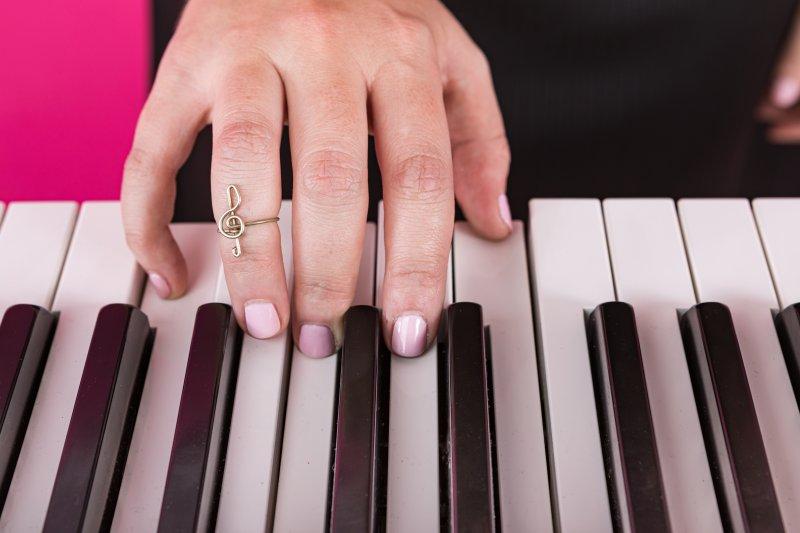Forgo the sheet music and try your hand at improvising! Get started with this exercise from Tucker, GA teacher Linda L...
Piano improvisation can seem daunting, but with a little practice, it can become second nature.
Improvising is all about expressing yourself, so don’t be afraid to let go and just play what comes to mind.
Improvising, in music, is making up your own music on the spot. It is truly “playing with” music, in the more common sense of the word “play.” It’s fun, creative, and, well, playful.
When it comes to piano improvisation, I tend to think of jazz, blues, and rock. But one can definitely improvise in any musical style.
Be creative and explore different harmonies and rhythms. You may also want to try creating melodies over chord progressions that you’re already familiar with. Start by playing the chords softly at first, and then gradually increase the intensity as you feel more comfortable.
It’s also important to stay relaxed and have fun while improvising! So go ahead and experiment with different sounds and techniques – the sky’s the limit when it comes to improvisation.
There is a lot you can learn when it comes to how to improvise on piano, and there is even more to explore on an electronic keyboard. For this article, I’ll focus on the latter.
Happy playing!
How Do You Improvise Chords on Piano?
To learn how to improvise on piano with chords, start by taking the following steps:
- Use the built-in rhythm and auto-chord features on the keyboard so you can focus on melody lines
- Listen to rhythm and chords on an acoustic piano
- Start with a rhythm style you like at a moderate tempo and use any minor or major chord
- Focus on the note that’s the root of the chord
- Use scales to give you a foundation to skip around to
Later in this post, we’ll walk you through all the steps you need to learn how to improvise chords on piano. For now, make sure you understand the fundamentals of the piano by signing up for piano lessons. Watching videos like the one below can also be helpful when you are learning how to improvise on piano:
https://www.youtube.com/watch?v=wE660yMZH4g
General Tips for Learning How to Improvise on Piano
If you want to know how to get better at improvising on piano, these general tips are a great place to start.
First, it’s important to understand the basic principles of harmony and how chords are built. This will give you a foundation to work from when creating your own melodies. Next, try choosing a simple scale or chord progression and experiment with different rhythms and melodic ideas.
Once you’re comfortable improvising within a certain framework, you can start to explore more complex harmonic concepts.
Finally, don’t be afraid to make mistakes. The beauty of improvisation is that there are no wrong notes, so go with the flow and see where your creativity takes you.
With a little practice, you’ll be surprised at how easy it is to add your own unique flair to any piano piece.
How Easy is it to Improvise on Piano?
With an electronic keyboard, you can use the built-in rhythm and auto-chord features to give you a virtual back-up band, which leaves you free to focus on melody line improvising. Of course, you can improvise on an acoustic piano just as well, and you can improvise melody lines without listening to rhythm and chords. But for beginning pianists, or those new to improvising, having the rhythm section and chords playing in the background gives you a starting point and framework. Also, you can set your keyboard to sound like other instruments, if you wish. Having a vibraphone, trumpet, or synthesizer sound can inspire you to play different sorts of melody lines and musical styles.
How to Get Started Improvising
There are many ways to get started improvising, but my favorite is to start with a rhythm style that you like, at a moderate tempo, and any minor or major chord. (You’ll need to learn how to use your keyboard’s preset rhythm and auto-chord features to do this. Look it up in the owner’s manual, if you don’t already know.) Once you start your rhythm and chord accompaniment playing, it will keep playing until you press the stop button. If you play another note in your auto-chord range, it will play the major chord based on that note. If you want a minor chord, you usually play two notes simultaneously — the note you want, with the note a ½-step above or below your root note. Which note will give you the minor varies among different types of keyboards.
Now, in one of the octaves above the auto-chord range, play the note that is the “root” of the chord you are listening to. For example, if you have set your keyboard to play an “A major” chord, play an “A.” Try repeating that note several times, in different rhythms – longer notes, shorter notes, some rests, etc., but keeping with the beat you have set.
Next, try playing the first 5 notes of the scale that go with the chord that you started on, both ascending and descending. If your chord is A Major, for example, you can play A, B, C#, D, E, and back down to A, OR you can use the A-major pentatonic (five-note) scale of A, B, C#, E, F#, and back down to A.
Keep to the background beat and tempo, but vary the rhythm. Play some quarter notes, some half notes, some eight notes, etc. Put in some rests. Repeat some of the notes.
Now start skipping around within your scale. Add in the rest of the notes of your major or minor scale. Try playing the notes of the chord you’re improvising to, varying the rhythm and the order of those notes. Try adding in some accidentals as “passing notes” – i.e., they will be part of a sequence of notes that lead to a note that is IN the key (and in the chord you’re playing with).
As a beginning improviser, you can try to create musical phrases that end on the root note of your chord. That’s always a safe place to end a phrase. You can also try playing more than one note at once, such as starting with two notes from the chord you’re playing with.
How to Improvise Chords on Piano
Adding to the Exercise
Your next step is to gradually start adding more chords, which will add more variety to your improvisation. You might try improvising on two chords that alternate every other measure, or a three-chord progression. (Remember, your keyboard’s auto-chord feature allows you to play any major or minor chord with just one or two fingers. As you get more advanced, you can add “7th” chords and other, more complex chords.)
You can also learn the chords to a song you like, and try making up a new melody to those chords. Your new melody might even be a sort of harmony or counterpoint to the original song you’re basing it on. (A famous example of an improvisation on a song that became a whole new song in its own right is Charlie Parker’s “Ornithology”, which was based on “How High The Moon”.)
Eventually, you will want to stop relying on the auto-chords, start learning to play the chords yourself, and put both hands to good use! Mostly, you will play chords with the left hand, and melodies with the right. But as you become more advanced, you can play chords and melodies with either hand.
It can also be very helpful to listen to some other keyboardists’ improvisations, in order to become familiar with a variety of improvisational styles. Pick your favorite genre of music, find songs in that genre with piano/keyboard solos, and spend some time listening. If you are able to play by ear, try learning the improvised solos that you like, and then try improvising off of those solos.
The 6-5-4-5 Piano Chord Progression for Improvisation
The 6-5-4-5 chord progression is a great way for beginners to improvise on the piano. To start, simply play the chords in order, starting with the root note of each chord.
For example, if you’re playing in the key of C, you would start with C, then move to F, then Bb, and finally back to C.
You can experiment with different rhythms and melodic patterns, but the basic idea is to keep the chords moving forward in a steady pulse.
As you become more comfortable with the progression, you can start to add in embellishments and embellishments. However, always be careful not to overdo it – too much noodling can ruin the flow of the piece.
With a little practice, you’ll be able to use the 6-5-4-5 progression to create beautiful and fluid improvised solos.
Modifying a 5 Chord to Inverted Chord
If you’re just starting out improvising on the piano, one of the easiest ways to do so is to modify a 5 chord. To do this, simply take any 5 chord and invert it. For example, if you’re playing a C5 chord, you would invert it by playing an E in the bass instead of a C. This gives the chord a whole new sound and feel, and opens up new possibilities for how you can improvise around it.
You can experiment with different inversions of chords to see what sounds best, and how it affects the overall tone of your improvisation.
With a little practice, you’ll be surprised at how easy it is to create interesting and exciting sounding solos simply by modifying chords in this way.
Best Scales for Learning How to Improvise on Piano
If you’re just starting to learn how to improvise on piano, you might be wondering what the best scale is to use. While there are many different scales that can be used for improvisation, the best scale for beginners is the major scale.
The major scale consists of seven notes, and it’s a great starting point for learning how to create melodies.
Once you’re familiar with the major scale, you can start exploring other scales, such as the minor scale or the blues scale. As you become more comfortable with improvisation, you’ll likely find that certain scales work better for certain genres of music. For example, if you’re playing jazz, the blues scale might be a good choice. Experiment with different scales and see what sounds best to you.
8th Notes for Improvising
One of the most important skills for a pianist is the ability to improvise. This means that you are able to create music spontaneously, without relying on sheet music or a predetermined melody. When improvising, it is important to start with a basic understanding of how to play 8th notes.
This will give you a solid foundation from which to build more complex melodies. Once you have mastered 8th notes, you can begin to experiment with different rhythms and dynamics. The goal is to create a musical phrase that flows naturally and sounds effortless. With practice, you will develop your own style of improvising and be able to spontaneously create beautiful music.
16th Notes for Improvising
One more tip on how to improvise on piano for beginners?
16th notes are a great place to start. Also known as semiquavers, 16th notes are played at twice the speed of 8th notes (quavers).
This means that there are four 16th notes in the time of one quarter note. When improvising, 16th notes can help to create a fast, flowing melody. To get started, try thinking of a simple melody or chord progression and then playing it using 16th notes.
You can also try adding embellishments such as trills or runs. With a little practice, you’ll be improvising in no time!
How to Do Improvisation on Piano With a Keyboard or Piano
Don’t have an electronic keyboard?
You can still practice improvising on an acoustic piano, starting with the same simple one-note-with-varying-rhythms and scale-based approach mentioned above, either without any chord accompaniment, or by playing simple chords with your left hand (one chord per measure will do for a start, and you can easily look up a basic “12-bar blues progression” if you want to improvise over a series of chords), and melody lines with your right hand.
Once you get comfortable doing this, try switching to chords with the right hand, and melody with the left, with the goal of developing equal dexterity in both hands.
Can Anyone Learn to Improvise on Piano?
Piano improvisation might seem challenging, especially if you don’t have an actual piano and just have a keyboard at your disposal. However, this is something that really and truly can be done by anyone!
Learning to improvise on the piano can be a fun and rewarding experience. If you’re just getting started, or if you feel like your improvisation skills could use some improvement, try out some of the tips we shared in this post. With a little bit of practice – and by taking lessons with a qualified piano instructor – you’ll be playing beautiful improvised melodies in no time!
Keep exploring! Check out even more piano improvisation exercises here!
 Linda L. teaches piano, guitar, songwriting, and more in Tucker, GA. She has more than 30 years of experience as a music teacher, for both private lessons and classes. Learn more about Linda here!
Linda L. teaches piano, guitar, songwriting, and more in Tucker, GA. She has more than 30 years of experience as a music teacher, for both private lessons and classes. Learn more about Linda here!
Photo by MIKI Yoshihito (´・ω・)
Suzy S.

